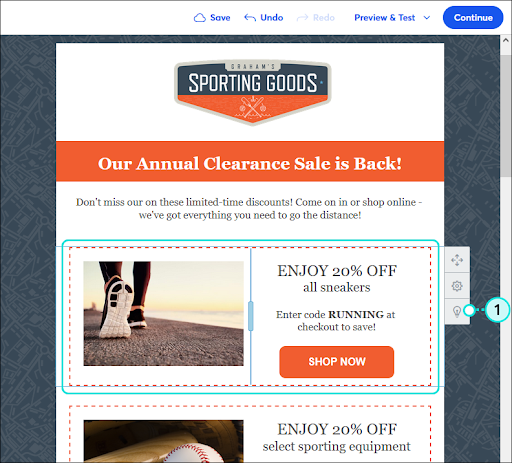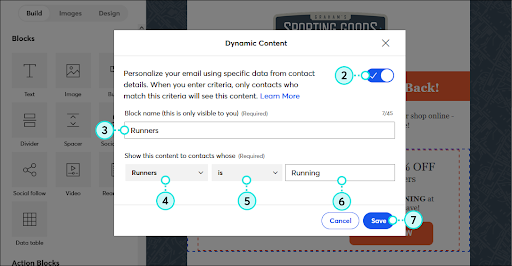
As time goes on, the technology we interact with becomes more and more personalized and automated. Streaming services like Netflix and HBO recommend old and new content that feels handpicked just for us. (Another cheesy rom-com? Don’t mind if I do.) Our social media feeds show us posts based on our interests. And streaming platforms like Spotify create custom playlists that match our vibes.
All this personalization makes it easy for us to feel like we’re the main characters in our own stories. And customers increasingly expect the same celebrity treatment from the brands they follow. According to McKinsey & Company, 71% of customers expect personalized interactions from companies.
Many businesses use dynamic email to give customers the personalization they crave. But what is dynamic email? We’ll get into the details below, but in a nutshell, these interactive messages let you customize your content for every customer. They’re a practical and simple way to take your email marketing to the next level.
This guide covers everything you need to know about creating dynamic email, its advantages, and some resources to help you get started.
What is dynamic email?
There are two main types of email: static and dynamic. Static emails are traditional messages with non-interactive content. That means every recipient sees the same content, no matter who they are or when they open the email. These emails are easy to create, but they’re not very personal.
Dynamic emails, on the other hand, have personalized content that automatically changes based on the recipient’s characteristics. These emails can include personal subject lines, images, product recommendations, and other elements.
Say you’re sending an email announcing a holiday clothing sale. You can add dynamic product recommendations based on the recipient’s age, gender, and purchase history. Or you can use location data to advertise winter coats to customers in Colorado and t-shirts to those in Florida.
The biggest difference between static and dynamic email is how long it takes to create customized content. With static email, you’d need to tailor your messages for each customer or segment and send the messages individually. This task takes a lot of time, especially if you have a mailing list with hundreds or thousands of customers.
But dynamic email lets you create a single message with dynamic content sections. The email platform automatically changes these sections based on data you’ve gathered for each recipient. That means you can craft one email that will look different for every customer.
Dynamic email is safe as long as you take property security precautions. Input validation, encryption, and security testing are all necessary to make sure that hackers can’t access dynamic elements. Luckily, reputable email marketing platforms use the latest security measures to keep customer data safe.
Examples of dynamic email content
To get a better idea of what dynamic email content is, it’s helpful to look at some examples of how these personalized elements change in real-time based on the recipient’s traits and interactions. Here are five popular types of dynamic email content often used by marketers.
Text personalization
With dynamic email, it’s possible to tailor the written portions of your message for your recipients. You can personalize the subject line and the body of the email.
For instance, a pet store retailer could use dynamic email to personalize messages based on the recipient’s animal. You could create pre-defined lists for small dog owners to receive content about pampering their pooch. Meanwhile, bearded dragon owners could read content related to lizards.
You can also use dynamic text to give real-time updates without sending more emails. For example, you can include a countdown for the days remaining on a sale. As time passes, the statement “Only five days left to save!” will automatically change to “Only four days!” and so on. Other dynamic text examples include live pricing and inventory counts.
Visual elements
You can personalize colors, images, videos, and other visual content for different audiences. Let’s say you have a store that sells clothing for children and teenagers. Soft pastels and pictures of children may appeal to mothers. Meanwhile, teens may feel drawn to more vibrant colors and photos of young adults.
Calls to action
Create dynamic calls to action (CTA) to encourage readers to engage in particular behaviors. A new customer at an outdoor supply store might receive this invitation: “Start exploring our must-have camping gear.” A returning customer could read this CTA: “Discover our new tent arrivals.”
Milestones
Many companies send emails celebrating milestones, such as customer anniversaries and birthdays. Dynamic emails let you tailor these messages based on recipients’ unique data.
Benefits of dynamic email
With so many opportunities for personalization, marketers across industries integrate dynamic email into their email marketing plans.
But what is dynamic content in email marketing good for, exactly? Here are some of the key benefits of dynamic email marketing:
- Improved customer experiences: Give your customers relevant and engaging content with dynamic emails. These messages add value to their lives by allowing them to see specific solutions to their problems and discover exciting products and services.
- Increased efficiency: Dynamic messages use email automation to save time and improve productivity. This content scales up quickly as your brand grows. Top platforms like Constant Contact also offer dynamic email templates so that you can whip up personalized emails in minutes.
- Higher campaign engagement and conversion rates: Customers are more likely to engage with content that fits their interests and needs. Increase conversion rate by using dynamic email to show individual clients how your brand can help improve their lives.
- Comprehensive data analytics: Dynamic email helps you understand how customers interact with your content. You can use this information to identify areas of improvement. Collect metrics like click-through rates, spam complaint rates, and delivery rates.
How can you send email dynamically?
Dynamic email may sound complicated, but you don’t need a computer science degree to use this technology. These six steps will help you create effective dynamic messages.
Gather customer data
You can’t personalize your content if you know nothing about your customers. That’s why it’s essential to collect customer data before you write your first dynamic email.
There are many ways to learn more about your customers, including:
- Browsing and purchase history: A customer’s past behavior can help you understand their needs and predict future behavior.
- Sign-up forms: Ask customers for basic information like their location and gender when they sign up for your mailing list and loyalty rewards program.
- Feedback forms and surveys: Invite clients to share their insights with you. Use feedback forms and surveys to ask about their pain points, preferences, and interests. Also, you can collect relevant demographic information, like age and location.
It’s crucial to respect your customers’ privacy throughout this process. Be transparent about how and why you collect data. You should also let clients opt out if they don’t want to share their information.
Segment your audience effectively
Email list segmentation involves dividing your customers into different groups with distinct characteristics. This process lets you target your email marketing more effectively without getting too specific. Creating dynamic emails tailored to five groups of customers could be as effective as writing separate emails for every individual.
Here are a few criteria often used to segment audiences:
- Behavioral patterns
- Demographics, such as age, gender, and profession
- Geographic location
- Hobbies and interests
- Purchase source
- Survey responses
Develop custom content for each segment
After you’ve divided your audience, customize your content. Consider these questions for each group:
- What are these customers’ goals, interests, and needs?
- What problems can I solve for this group?
- What marketing strategies appeal to these clients?
- What type of content does this group prefer to consume?
- What language resonates with this group?
- How does my brand fit this group’s lifestyle and values?
- What current trends are relevant to these customers?
Use your answers to these questions to create more tailored content. For instance, videos may appeal to younger customers, while older audiences may prefer informative blog posts.
Add dynamic content and other design elements
Follow these email marketing best practices to create compelling dynamic emails:
- Include personalized greetings and subject lines
- Use responsive templates that display on smartphones, computers, and tablets
- Add dynamic blocks strategically to avoid overwhelming readers
- Use branded templates to make your emails look consistent and professional
- Choose dynamic images that resonate with each segment
- Conclude with personalized and persuasive CTAs
- Edit and proofread content thoroughly
Test and optimize your dynamic emails
Send test emails to make sure your messages display correctly on different devices. Double-check all the hyperlinks, images, and personalization features. It’s also helpful to read the text out loud to pick up on grammar and spelling errors. These simple steps will help you send professional and polished dynamic emails.
When you’re ready to debut your dynamic emails, you can use A/B testing to improve your performance. This method involves sending different versions of emails to your audience and using data analytics to track engagement. For instance, you might test two different CTAs to see which entices readers the most. This knowledge helps you optimize your emails over time.
Creating dynamic content sections

When you’re ready to craft dynamic emails, start by planning content that you can adapt for different audiences. You can customize features like greetings, product recommendations, and CTAs for each segment. You might find it helpful to start small with one or two dynamic elements. As you gain confidence and experience, you can add more dynamic sections.
Develop customer personas to guide your content creation. Invent characters who represent your ideal customers and identify their goals and interests. Next, brainstorm content and language that appeals to each persona.
You’ll also need to set up and update subscriber profiles in your chosen email platform. This process may involve sending surveys or using sign-up forms to collect data. You can use this information to segment your readers.
Key steps to set up dynamic email campaigns

The process of setting up dynamic email campaigns varies by platform. But you can expect these basic steps:
- Gather and organize data for personalization. Collect customer data using sources such as website analytics or sign-up forms. Many platforms have plugins that track how customers interact with your website. This data lets you send personalized emails based on their browsing history. Be sure to tell clients how you plan to use their information. Then, organize this data into different segments.
- Add contact attributes. Create a series of tags that you can use to sort your customers into groups. Common attributes include age, frequency of transactions, and customer lifetime value.
- Create and integrate your dynamic content. Using the personalized categories you’ve already chosen, insert your dynamic content into your email platform. For instance, you may need to dynamically insert the recipient’s name into the subject line, or you can incorporate dynamic images based on the recipient’s demographics.
- Add dynamic emails to your marketing automation workflows. Save time by automating dynamic emails. For example, you can set up an email drip campaign that sends contacts a series of emails over time. You could send clients a welcome email when they join your mailing list. A week later, you could follow up with custom product recommendations.
- Incorporate other marketing strategies. Pair dynamic emails with other marketing methods for maximum effectiveness. You could use SMS and email marketing to increase engagement. Or, you might add social media content to dynamic emails to boost interaction.
Tools and resources for dynamic email
There are many resources to help you customize dynamic emails. Start by choosing an email marketing software with dynamic capabilities.
Constant Contact makes it easy to add dynamic content to emails. You can create dynamic images, text, CTAs, and other elements with the click of a button.
Choosing an email platform that integrates with customer relationship management (CRM) software is also essential. Combining these tools lets you scale up your email campaigns as your business grows. Constant Contact has a built-in CRM. It can also integrate with your existing system.
Additionally, you should look for software with privacy and consent management features. Use Constant Contact’s email templates to confirm consent and get access to advanced security measures that protect client data.
Here are other features to look for when shopping for dynamic email software:
- A/B testing: Experiment with different content to figure out what works best for your customers.
- Automation features: Boost your productivity by choosing a platform that automates email workflows.
- Customer support: A responsive customer support team can help you troubleshoot your dynamic messages.
- Educational resources: Some vendors offer videos, how-to guides, and other training resources.
- Pricing structure: Many vendors offer multi-level plans, which means you only pay for the features you use.
Get ready to deliver top-notch content
Dynamic email is key to successful modern email marketing. This powerful tool lets you deliver personalized content straight to your contacts’ inboxes. Dynamic messages increase engagement and give your clients more meaningful content. You’ll also get valuable data you can use to improve future email campaigns.
To get started on your dynamic emails, try segmenting your email list based on one or two factors, such as age or purchase history. Then, you can get an idea of how different types of dynamic content might appeal to these groups.
Explore Constant Contact’s blog to learn more about strategies that you can use to personalize content and automate your marketing workflows.




